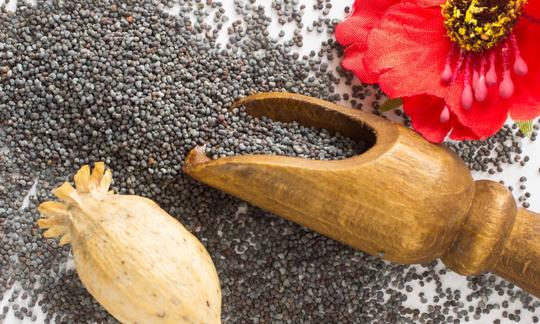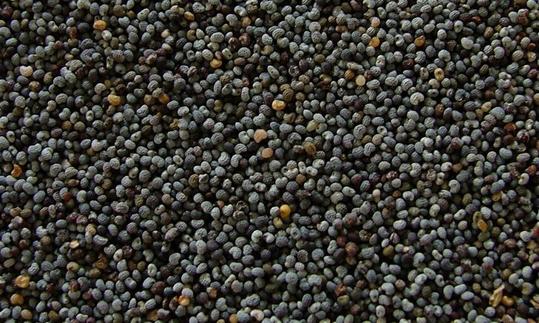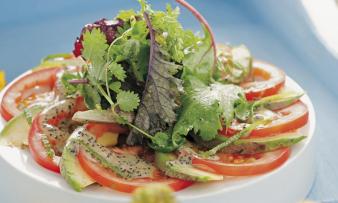Table of contents
The term poppy seed refers to the seeds of the opium poppy ( Papaver somniferum ). Poppy seeds contain many healthy macronutrients, but their fatty acid ratio is questionable.
Use in the kitchen:
The poppy seeds of the opium poppy are mostly found in desserts and baked goods such as poppy seed cakes, poppy seed strudels, poppy seed tents, poppy seed noodles or yeast dumplings, which are traditional in Austria, the Czech Republic and Slovakia. The dark poppy seeds in ground form are ideal for filling these dishes (poppy seed mill or mortar). Bread rolls sprinkled with poppy seeds also taste savoury and they can also be added raw to marinades for salads, dips or sauces to refine them. Fragrant poppy seeds in muesli or as a spice give the dishes a pleasant nutty taste. Ground white or yellow poppy seeds can be found in many Indian curry mixtures. These are also used ground like flour to thicken sauces.
White poppy seeds taste the nuttiest, grey poppy seeds are milder, and blue poppy seeds are spicier.
With a fat content of 40-50%, the seeds are ideal for producing cold-pressed poppy seed oil. It is always used (similar to linseed oil ) just before serving and should not be heated.
Vegan recipe for poppy seed and lime dressing:
Mix the poppy seed, lime juice , rapeseed oil (cold-pressed) , balsamic vinegar , agave syrup , salt andpepper together and drizzle over the salad. For more precise quantities, please read the recipe for tomato avocado carpaccio with poppy seed and lime dressing .
Vegan recipes with poppy seeds can be found under the note: " Recipes that have the most of this ingredient ".
| Not only vegans or vegetarians should read this: Vegans often eat unhealthily. Avoidable nutritional mistakes . |
Shopping - where to buy?
Whole poppy seeds are available at all conventional supermarket chains such as Coop , Migros , Denner , Volg , Spar , Aldi , Lidl , Rewe , Edeka , Hofer etc. These are often a mixture of grey, blue and blue-black seeds. Ground or crushed poppy seeds are usually available under the name "baking poppy seeds" and are often already sweetened. In selected supermarkets, organic shops and health food stores you can also get organic poppy seeds, sometimes even single varieties. You can also buy white or yellow poppy seeds in specialty shops or online.
Found in the wild:
A related, wild-growing species is the wild corn poppy ( Papaver rhoeas ), which, like the opium poppy ( Papaver somniferum ), belongs to the poppy family ( Papaveraceae ). The slightly poisonous plant is not usually used, but the seeds, flowers and leaves of the wild plant are sometimes used in cooking and as a medicinal plant. 1,2 The plant genus has between 50 and 120 species worldwide, including the cultivated plant opium poppy. Those varieties with steel-blue seeds are most similar to the wild form. Wild-growing from the same family is greater celandine ( Chelidonium majus ), which has an antibacterial, antiviral and slightly poisonous yellow plant sap.
Storage:
Whole poppy seeds will last for several months if stored in a dark, cool place and in an airtight container. Opened packages should be kept in the refrigerator and consumed within a few days. Ground poppy seeds have a similarly limited shelf life. Due to the high oil content, damaged seeds spoil more quickly, which can be recognized by a rancid taste. However, ground poppy seed mixtures can be frozen for up to two weeks.
Ingredients - nutritional value - calories:
Poppy seeds have a very high energy content of 525 kcal/100g. This is mainly due to the high fat content, which makes up 42%. But the carbohydrate content (28%) and the protein content (18%) are also considerable. Eating 100 g of poppy seeds covers 335% of the daily requirement of manganese (6.7 mg/100g). Spices such as fennel seeds or dried thyme have similar values of this trace element, but you consume significantly less of them.
The content of the macro-mineral calcium is equally impressive: 1438 mg/100g of poppy seeds cover 180% of the daily requirement. Only dried herbs such as oregano or rosemary can offer similar values. Although 0.84 mg of thiamine (vitamin B 1 ) per 100 g may seem a little meager, this amount covers around 78% of the average woman's daily requirement. This is comparable to pulses such as lentils or soybeans . 3 For more information, please see the nutrient table at the end of the text.
You can find all the ingredients, the coverage of the daily requirement and comparison values with other ingredients in our nutrient tables. In the article Nutrients explained you will get a detailed insight into the topic.
Health aspects - effects:
The pain-relieving effect of the opium poppy has been known for a very long time in the field of medicinal plants. The morphine contained in the opium poppy has been known in its pure form since 1804. As a strong painkiller, it is still used today in conventional medicine against many diseases, such as cancer or severe chronic pain. 4
The intoxicating substances are the alkaloids contained in the white milky sap, such as morphine, codeine, papaverine, noscapine, thebaine and narceine. These alkaloids act on specific receptors in the brain and the gastrointestinal tract. 5 To make opium, the thick, swollen, green poppy capsules are lightly scratched in the evening. This allows the milky sap to flow out. This dries overnight and can be removed and processed further. One capsule gives you around 20-50 mg of raw opium, which contains 3-23% morphine.
Morphine can be addictive and an overdose can lead to respiratory depression and death. This powerful opiate is therefore subject to the Narcotics Act. The effect of codeine is only one sixth to one twelfth of that of morphine. It is used for severe dry coughs. Heroin is produced by chemical derivatization (acid ester formation) of morphine. It has 3-6 times the analgesic effect of morphine. Heroin itself is not contained in poppy seeds. 6
Dangers - intolerances - side effects:
There is some debate about whether poppy seeds are a superfood. It does contain an enormous variety of vitamins and trace elements, but the fatty acid ratio of poppy seed oil is particularly unfavourable. The aim is to achieve a fatty acid ratio of linoleic acid to alpha-linolenic acid (LA:ALA) of almost 1:1. At 104:1, the omega-6 fatty acids, which are considered to promote inflammation, are far too high. The ratio for cashew nuts is even worse, namely 130:1, but they contain "only" 7.8 g instead of 28 g of linoleic acid per 100 g. However, you eat more of them. In comparison, cold-pressed linseed oil has a particularly good ratio of 1:3.7. More on this in the text in the box to the left above, which is very important for health.
The myth that poppy seeds are poisonous has long been disproven. Provided that you don't abuse them. The morphine and codeine contained in the seeds of the edible poppy are actually very small and therefore harmless. In some cases, however, contamination has occurred during harvesting. If there are too many alkaloid-containing capsule fragments in the harvest, the morphine content can be increased, so health risks cannot be ruled out.
During pregnancy, it is now generally advised against excessive consumption of foods that contain a lot of poppy seeds. 14 Eating foods that contain poppy seeds can also trigger an opiate drug test, even if the amount is in a safe range. For this reason, foods that contain poppy seeds have been banned in German prisons. 7
There are people who react allergically to opium poppy plants when they come into contact with their skin or when they ingest the seeds. However, these allergies are rather rare. The poppy seed allergen sometimes has a limited heat stability (after cooking or baking). 8 There are also cross-reactions: people who are allergic to nuts can be intolerant to poppy seeds. 9 Allergic reactions after eating poppy seeds can cause stomach pain, nausea, itching in the mouth or swollen lips and tongue. 10
Folk medicine - natural medicine:
In ancient Greece, opium was used for cultic and medicinal purposes, in the Roman Empire the opium poppy was known as a drug of prosperity. Opium poppy was also used externally. Poppy was used as a balm, ointment, oil or as a thick sugar mass to treat pain, fever and the plague. The whole seeds were taken to treat diarrhea. 4
Opium and opium tinctures are known in folk medicine as a cough medicine and also as a remedy for diarrhea.
Occurrence - Origin:
The opium poppy ( Papaver somniferum ) is a very old cultivated plant. Its origins lie in the eastern Mediterranean. In southern Europe, the opium poppy has been cultivated as a crop since the Neolithic period (6000 BC). Written records of its pharmaceutical use date back to 4000 BC. 11
White varieties, i.e. white poppy seeds, are mainly cultivated in India. The varieties traded in Germany (blue seeds, also called blue poppy) are mostly from Turkey, the Czech Republic, Hungary and Australia. Small quantities of opium poppy are also produced in Germany, Austria and Switzerland. The most important countries producing opium poppies for opium production are Afghanistan, Myanmar, Mexico, Laos, Pakistan and Colombia. 12
Cultivation - Harvest:
The legal situation for the cultivation of opium poppies is not the same everywhere. In Germany, the cultivation of poppies as a cultivated and ornamental plant requires a permit. In Austria, however, poppy cultivation has an old tradition. The well-known variety "Waldviertler Grauohn" also originated there. In the USA, the cultivation of opium poppies is permitted, but the extraction of opiates is illegal. In Saudi Arabia, the UAE and Taiwan, it is not permitted to possess opium. In China, the use of opium poppies as food is even prohibited, but you can buy them in West Indian markets. 6
As an annual, herbaceous plant, the opium poppy reaches a height of 0.3-1.5 m. Its flowering splendor only lasts for about 2 days, then the purple, pink or white flowers fall off again. The spherical capsule contains hundreds of seeds. Their colors range from white, yellow, gray, blue to black-blue.
Danger of confusion:
The opium poppy ( Papaver somniferum ) can be confused with the corn poppy ( Papaver rhoeas ) and the seed poppy ( Papaver dubium ). All contain alkaloids, but in varying strengths. The opium poppy can usually be recognized by the color of the flowers. The opium poppy has light purple flowers with a dark purple base inside. The entire plant is blue-green. 5 Corn poppies can usually be recognized by their purple flowers, which are rarely white or purple, and the bristles stand out on the stems. Seed poppies can bloom in colors ranging from white to yellow to orange-red, and the stems are hairy.
General information:
The opium poppy (Papaver somniferum) takes its name from the Latin: "somniferus" means "sleep-bringing". In ancient Greece, poppies were given to children as a sleeping aid.
Poppy seeds are not only suitable for human consumption, they can also be used to enrich animal feed. Other uses: Poppy seed oil from opium poppies is used as a cosmetic ingredient in the production of skin creams and soaps.
Alternative names:
Opium poppy is also known as true poppy, garden poppy (but also an alternative name for Turkish poppy) and light scales. 13
The general English name for poppy is poppy, poppy seeds are poppy seeds and opium poppy is known as opium poppy or garden poppy.
Literature - Sources:
Bibliography - 14 Sources
| 1. | Fleischhauer SG, Guthmann J, Spiegelberger R. Essbare Wildpflanzen. 200 Arten bestimmen und verwenden. Weltbild: Augsburg. 2013. |
| 2. | Pahlow M. Das grosse Buch der Heilpflanzen. Gesund durch die Heilkräfte der Natur. Nikol Verlag: Hamburg. 2013. |
| 3. | USDA United States Department of Agriculture. |
| 4. | Zeitung.de Schlafmohn - Mohngewächs mit toller Wirkung? |
| 5. | Fleischhauer SG, Guthmann J, Spiegelberger R. Enzyklopädie Essbare Wildpflanzen. AT Verlag: Aarau. 2018. |
| 6. | Wikipedia (German language). Opium Poppy. |
| 7. | Spiegel. de Mohnbrötchen-Verbot im Knast. |
| 8. | Alles-zur-Allergologie.de Mohnsamen. |
| 9. | Allergie-ratgeber.de Kreuzallergien Nahrungsmittelallergien. |
| 10. | Allergiefreie-Allergiker.de Mohnallergie. |
| 11. | Seefelder M. Opium. Eine Kulturgeschichte. Ecomed. Landsberg. 1996. |
| 12. | Statista.com Anbaufläche für Schlafmohn. |
| 13. | Heilkraeuter.de Schlafmohn. |
| 14. | BfR Bundesministerium für Risikobewertung. Erhöhte Morphingehalte in Mohnsamen: Gesundheitsrisiko nicht ausgeschlossen. 2006. |











Comments